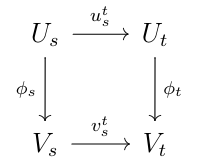Questions:
- ”… is a locally finite subset of …”
- Answer: A locally finite poset is a poset such that for all the interval is finite. (https://en.wikipedia.org/wiki/Locally_finite_poset)
- Homology of sublevel sets
- Answer: 2024-08-23
- Computing multiplicity, e,g, , without knowing the interval decomposition.
- Counterexample by Webb in Theorem 1.4 on page 13.
- Proof for Theorem 3.5.
Full paper can be found at: https://arxiv.org/abs/1207.3674
Smaller summary can be found at: 2024-08-30
An interleaving is an approximate isomorphism between two persistence modules. Moreover, the isometry theorem states that the interleaving distance is equal to the bottleneck distance under the assumption that the persistence modules are -tame. A more general theorem is provided that does not depend on tameness.
Multisets
Persistence diagrams are multisets. We can think of a multiset as a pair where is the set and is the multiplicity of each element in .
- The cardinality of is the sum
- We can restrict a multiset to a set :
- A pair with defines a multiset where
- Given , the image is the multiset in with multiplicity
Persistence Modules
All vector spaces are taken over an arbitrary field .
Persistence module over a real parameter
A persistence module over is the indexed family of vector spaces with a family of linear maps such that whenever and .
One may replace with any poset . In such a case, we call a -persistence module. In practice, .
We can visualize this as a chain:
A classic example is sublevel sets:
with inclusion maps
Functors from topological spaces to vector spaces also give rise to persistence modules. For example the -dimensional singular homology functor gives rise to the persistence module composed of with maps on homology induced by the functor on inclusion maps.
Quite often our space is a finite simplicial complex and each forms a subcomplex. As increases there are finitely many ‘critical values’
As a result, they are often -tame, i.e., whenever . The map from -tame persistence modules to persistence diagrams is an isometry, i.e., a distance-preserving transformation between metric spaces.
Category of Persistence Modules
Homomorphism between persistence modules
A homomorphism between two -persistence modules is a collection of linear maps
such that the diagram
commutes for all .
-persistence modules with the above homomorphisms defines a category. The identity map is the collection of identity maps . Composition is defined in the “obvious manner”, for and the composition is the collection of composed linear maps .
Interval Modules
Let where is an interval. We define the -persistence module with spaces
and maps
Example: Assume that . Then the -interval module is the following persistence module:
represents a feature that persists over an interval but is absent elsewhere. For example in homology groups, may represent classes that persist over but are not present outside of .
For there are four types of interval modules: , , , . Some sources write them as instead. However, over two interval modules may have the same endpoints but with different topology, e.g., vs .
Some sources use decorated real numbers:
If the decoration is unknown we use an asterisk .
Interval modules can be visualized on the half-plane . An interval module is either represented:
- as an interval on the real line
- as , viewed as a function
- as a point with a tick specifying the decoration. There are four possible tick directions:
 The convention is that they point into the quadrant suggested by the decoration (This is unclear).
The convention is that they point into the quadrant suggested by the decoration (This is unclear).
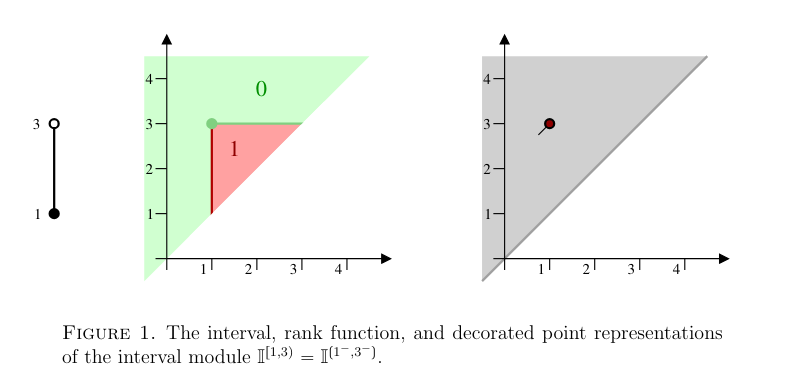
The classical persistence diagram draws points without indicating the decoration.
Interval Decomposition
Recall the direct sum of vector spaces. Given vector spaces and , the direct sum is the vector space when . The direct sum is isomorphic to the direct product, i.e., the vector space consisting of all ordered pairs with operations defined component wise:
Moreover, given two maps and , we can create the map by defining it component wise
We can then define the direct sum of persistence modules.
Direct Sum
Given two -persistence modules , the direct sum consists of the vector spaces with linear maps
An alternative viewpoint is we are decomposing a persistence module into smaller persistence modules and . We say a persistence module is indecomposable if the only decompositions are the trivial or .
Our goal is decompose a persistence module into an indexed family of interval modules:
This is a generalization of what we do with homology groups. For example, if we have filtration of a simplicial complex
then we obtain a persistence module with linear maps induced by inclusion
This persistence module then decomposes into a persistence module formed by interval modules
Proposition 1.1
Let be an interval module over . Then .
Proof: Let . Then each is an endomorphism on 0 or . In the non-trivial case, is the only possible endomorphism. Notice that for all
and
But . Therefore, .
Q.E.D.
Proposition 1.2
Interval modules are indecomposable.
Proof: Assume that . Notice that the projection map is idempotent, i.e., , in . From the previous proof we know that the only idempotent endomorphisms are 0 and . Therefore, the projection map is either trivial or an isomorphism.
Q.E.D.
Theorem 1.3 (Krull-Remak-Schmidt-Azumaya)
Suppose that a -persistence module decomposes in two ways:
Then there is a bijection such that for all .
In other words, decomposing a -persistence module into interval modules is unique up to order.
Theorem 1.4 (Gabriel, Auslander, Ringel-Tachikawa, Webb)
Let be a persistence module over . Then can be decomposed as a direct sum of interval modules if
- is a finite set; or
- is a locally finite subset of and each is finite-dimensional.
If either condition (1) or condition (2) in the above theorem hold, we can define a persistence diagram. However, we then see that not every persistence module over is guaranteed an interval decomposition. For example, consider the following (from Webb) persistence module over the non-positive integers:
with maps given by inclusion for .
Suppose has an interval decomposition. Every map is injective so each interval is of the form or . Moreover, implying that the interval does not occur. Hence, . But is uncountable, a contradiction.
If conditions (1) and (2) are not satisfied, one may
- Work in restricted settings so that only depends on finitely many indices ,
- Sample the persistence module over a finite grid, or
- Show that the persistence intervals can be inferred from the behavior of on finite index sets.
The persistence diagram of a decomposable module
(Un)decorated persistence diagram
If a persistence module can be decomposed as
then we define the decorated persistence diagram to be the multiset
and the undecorated persistence diagram as the multiset
where is the diagonal in the plane.
The persistence diagram does not depend on the order of interval modules in the decomposition (see Theorem 1.3).
Example:
Consider the curve in below filtered by height:
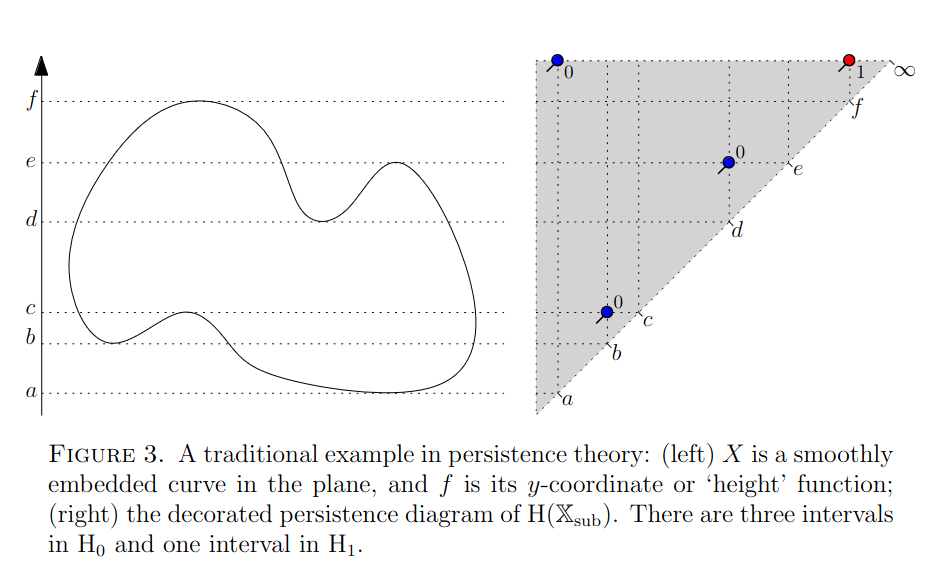
The sublevelset persistent homology decomposes as follows:
Quiver calculations
Let be a persistence module over a finite subset of the real line. We may view as a diagram of vector spaces and linear maps:
Such a diagram is a representation of the quiver
For example, if then
is the interval module over given by . With quivers we use filled circles where the module has rank 1 and open circles where the module has rank 0.
Multiplicity
Let be a persistence module indexed over . If , then we define the multiplicity of in to be the number of copies of in the interval decomposition of .
We write
for the multiplicity of in the module
Given a linear map ,
The conullity is the dimension of the cokernel, for linear map , the cokernel of is the quotient space .
Proposition 1.9 (direct sums)
Suppose is the direct sum of persistence modules,
Then
for any index set and interval .
In other words, the multiplicity of in is the sum of multiplicities of in each component.
Proposition 1.10 (restriction principle)
Let be finite index sets. Then
where the sum is over all intervals which restrict over to .
Example: Let and consider new indices and such that . Then
and
Notice the second term is due to both and both restricting to .
We can make use of proposition 1.10 to prove statements about ranks: Example: We wish to show that when . Notice that
Rectangle Measures
Right now our definitions for (un)decorated persistence diagrams requires knowing the interval module decomposition of our persistence module. We want a simpler methodology for constructing persistence diagrams. For that we use measure theory.
Persistence Measure
Let be a persistence module. The persistence measure of is the function
defined on rectangles in the plane where .
That is, the persistence measure is the number of copies of in the interval decomposition of .
This “measure” is easy to calculate on interval modules.
Proposition 2.1
Let where is a real interval. Let where . Then
Proof: Notice that when
which occurs if and only if and .
Q.E.D.
Graphically we can determine when decorated point are detected by :
- If is in the interior of , then is always detected
- If is on the boundary, then is detected if the tick is pointed inwards.
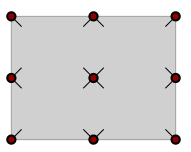
Thus, we say that a decorated point if the point and its decoration tick are contained in the closed rectangle . This is equivalent to . We denote the set of points in by
Corollary 2.2
Suppose is a decomposable persistence module over , then
Proof: By Proposition 1.9 and 2.1,
Q.E.D.
With this we can layout the strategy for defining persistence diagrams without decomposing:
- construct the persistence measure ;
- let be a multiset in the half-plane such that holds for all rectangles .
Proposition 2.3
Let be a persistence module and . If the spaces , , , are finite-dimensional or , then
Proof: By the restriction principle:
All the terms are finite.
Q.E.D.
Moreover, the measure is additive with respect to vertical or horizontal splitting of the rectangle:
Proposition 2.4
Whenever we get that
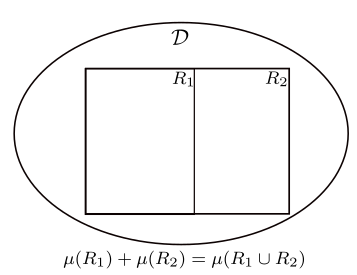
Proof: Notice that by direct calculation using the restriction principle
A similar calculation follows for vertical splits.
Q.E.D.
Abstract r-measures
Rectangle Measure
Let . Define
i.e., the set of closed rectangles that are contained in . A rectangle measure or r-measure on is a function
that is additive under vertical and horizontal splitting (satisfies Proposition 2.4).
The -measure assigns each closed rectangle that lies inside of the dataset either infinity or a non-negative integer such that splitting a rectangle does not change the total “area”.
Proposition 2.6
Let be an -measure on . Then
- (finitely additive) If with disjoint interiors, then .
- (monotone) If , then .
Proposition 2.7
If is such that with each , then
Equivalence of measures and diagrams
There is a correspondence between -measures and decorated diagrams.
Interior
The interior of is given by
where is the interior of the closed rectangle . The r-interior of is
The interior is defined similarly to interior in topology. A point is in the interior of if we can put an open rectangle around the point that is contained inside of . For -interior, the only difference is we also include the tick decorations of points.
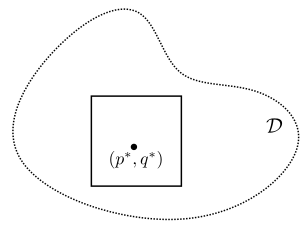
Theorem 2.8 (The equivalence theorem)
Let . There is a bijective correspondence between:
- Finite -measures on ( for all .
- Locally finite multisets in for all ).
The measure corresponding to the multiset is related by the formula
for every .
The cardinality of is given by
where is the multiplicity function for . Essentially, the measure of a rectangle can be done by counting the number of decorated points that lie inside .
Proof Sketch:
- The correspondence from locally finite multisets in to finite -measures is given by the fact that is a finite -measure.
- The other direction: for define
- Use induction on to show that
- Base case ($\mu(R)=0$): $0\le m(p^*,q^*)\le\mu(R)=0$.
- Inductive step: split rectangle into four quadrants $R=S_1\cup\cdots\cup S_4$. Each quadrant satisfies $\mu(S_i)=\nu(S_i)$ by the inductive hypothesis. By finite additivity we get that $\nu(R)=\mu(R)$. If one of the quadrants has $\mu(S_i)=k$ then the rest have $\mu=0$. In such a case we repeat the subdivision on $S_i$. This either terminates or gives us a sequence of closed rectangles
$$
R_0\supset R_1\supset\cdots
$$
- with each $\mu(R_i)=k$. The only contribution to $\nu(R)$ is then the decorated points $(p^*,q^*)$ that belong to each rectangle in the sequence.
- Show that if for some other multiplicity function , then .
This immediately results in the following definitions:
- The decorated diagram of is the unique locally finite multiset in such that
for every . 2. The undecorated diagram of is the locally finite multiset in
obtained by forgetting the decorations and restricting to the interior.
Non-finite measures
We now consider the case where the -measure is not finite.
Finite interior
The finite interior of an -measure is given by
The finite r-interior is then
This is the same as interior and -interior with the caveat that we now also require our rectangle to have finite measure.
We apply Theorem 2.8 (the equivalence theorem) to each rectangle with finite measure and get a decorated diagram in . We then stitch together the local definitions to get the multiset in the entirety of . This multiset satisfies
for any rectangle with finite measure.
Proposition 2.14
Let . If , then .
Corollary 2.15
Let be an -measure on . Then there is a uniquely defined locally finite multiset in such that
for every with .
Proposition 2.14
Let . If , then .
Hence, we can define the diagrams for any general -measure:
- The decorated diagram of an -measure is the pair , where is the multiset in )$ described in corollary 2.15
- The undecorated diagram is the pair , where
The diagram at infinity
We focus on -measures in the extended plane which now requires discussion of infinite rectangles.
The -interior and interior of remain primarily the same with the subtlety that now is the relative interior, e.g., if with finite, then .
We define the singular support of as
Corollary 2.15 still holds for -measures in the extended plane. We can view as a rectangle in via a transformation with homeomorphic embeddings, e.g.,
identifies with the rectangle . Both Theorem 2.8 and Corollary 2.15 are invariant under such a transformation.
Let be a persistence module. The persistence measure previously defined by
for extends to infinite rectangles where or by setting . Such a choice gives us the k-triangle lemma:
One may view as an -measure on the extended half-plane
and its diagram is defined on the finite -interior .
Corollary 2.17
If is decomposable into interval modules then counts the interval summands corresponding to decorated points which lie in .
In other words, simply counts the number of decorated points that lie inside .
There are three cases of relevance for the ‘measure at infinity’:
- the line :
- the line :
- the point :
The above limits exist when the rectangles in the expression belong to .
Diagrams of persistence modules
We have defined two definitions of diagrams of persistence module:
- Decomposition of intervals gives the multiset
- For persistence measure of gives the multiset that satisfies
for all rectangles .
Proposition 2.18
If is decomposable into intervals, then agrees with where the latter is defined on .
Example 2.19: Let
where the undecorated pairs form a dense subset of the half-plane . Notice that that for any rectangle , because the pairs are dense, i.e., there are infinitely many points in every rectangle. Hence,
Therefore, the multiset is nowhere defined.
Example 2.20: Consider the persistence module
defined by
???
Tameness Conditions
We say a persistence module is of finite type if it is a finite direct sum of interval modules. It is locally finite, if it is a direct sum of interval modules such that every has a neighborhood which meets only finitely many of the intervals.
Proposition 2.21
A persistence module is locally finite if and only if
- each is finite-dimensional
- there is a locally finite set such that is an isomorphism for every pair with .
Condition (2) asserts that is constant over each interval of the open set .
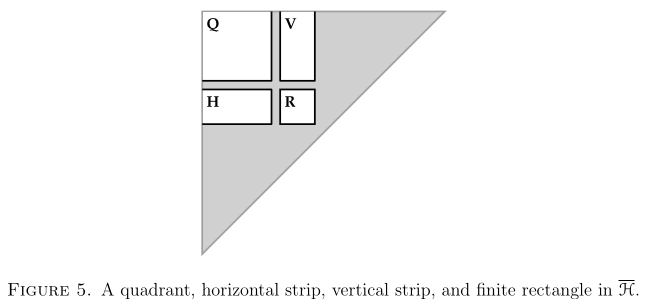
There are four kinds of tameness relating to the measure of various types of rectangles in :
- We say is q-tame if for every quadrant (infinite rectangle) not touching the diagonal, i.e.,
for all .
- We say is h-tame if for every horizontally infinite strip not touching the diagonal, i.e.,
for all .
- We say is v-tame if for every vertically infinite strip not touching the diagonal, i.e.,
for all .
- We say is r-tame if for every finite rectangle not touching the diagonal, i.e.,
for all .
One may show that
and the following diagram of inclusion:

Interleaving
Two persistence modules are said to be isomorphic if there are maps
such that
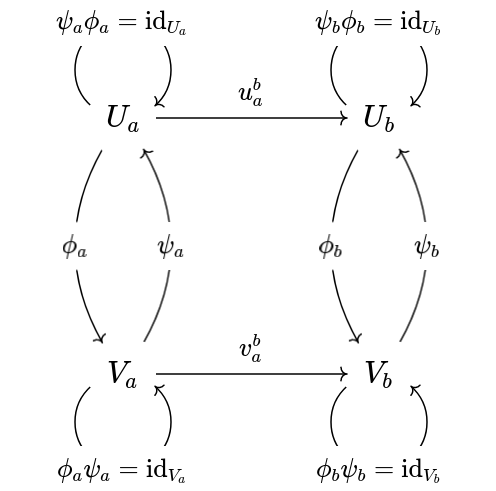
Such a relation is too strong to be used in practice. Instead we introduce a weaker relation known as -interleaving where quantifies a level of uncertainty.
Shifted Homomorphisms
Let be persistence modules over and . A homomorphism of degree is a collection of linear maps
for all such that the diagram
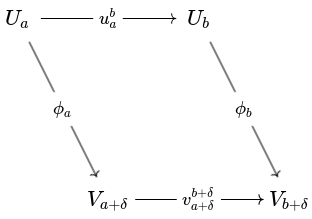
commutes whenever .
We denote the set of homomorphisms of degree by . One may compose two homomorphisms of degree and to get a homomorphism of degree .
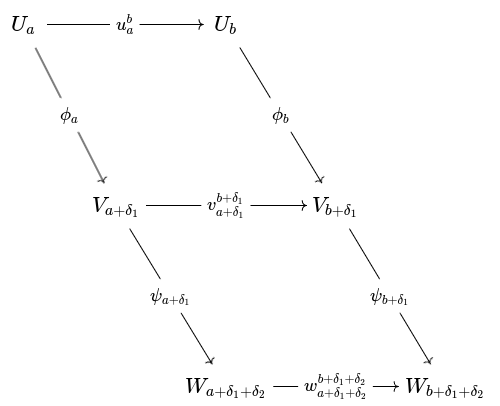
For a crucial degree- endomorphism is the shift map that is given by the collection of maps from the underlying persistence structure on . This map satisfies
for any and , i.e., the diagram below commutes for all and .
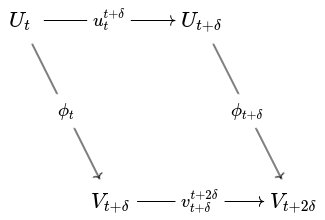
Interleaving
Two persistence modules are said to be -interleaved if there are maps
such that
in other words, for all the diagrams below commute:
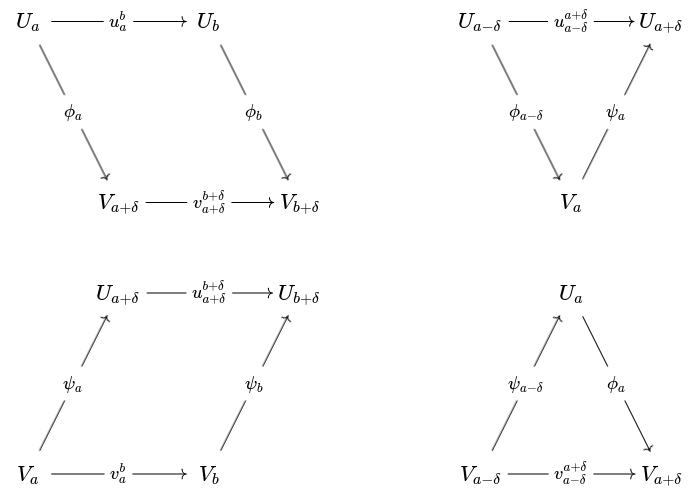
Example 3.2. Let be a topological space and let . Suppose . Then the persistence modules and are -interleaved by the homomorphisms of degree
induced by inclusion
An interleaving between two persistence modules can be viewed as a persistence module over a poset. Consider the standard partial order on :
Then for any we define the poset
that is isomorphic to by .
Proposition 3.3
Let . Persistence modules are -interleaved if and only if there is a persistence module over such that and .
For and , we may visualize as follows:
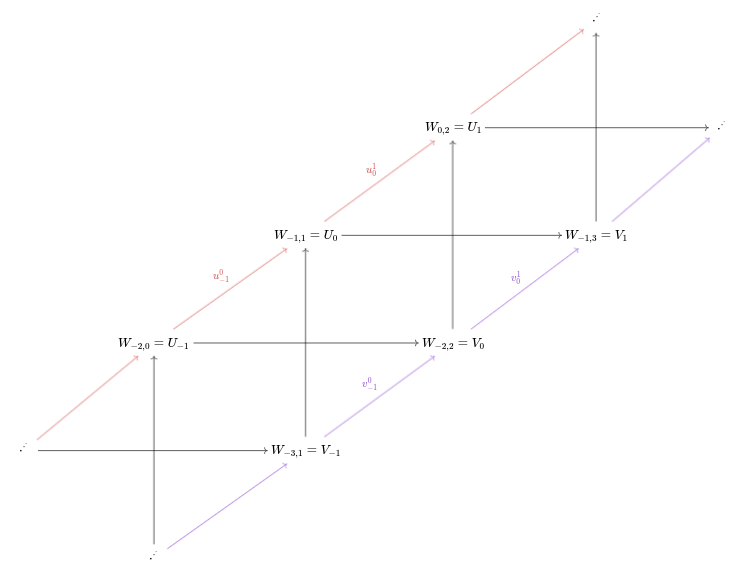
Proof: Assume WLOG that .
- Since are -interleaved, there are -degree homomorphisms
such that for all
- The persistence module maps satisfy
for all in . Notice that
by the isomorphism for . Moreover all maps , where , in can be factored as
So every map in is of the form
One may then show that the composition law is satisfied.
Q.E.D.
The Interpolation Lemma
Given two -interleaved persistence modules and , we can find a family of persistence modules that “continuously” transforms between and .
Lemma 3.4 (Interpolation Lemma)
Suppose are a -interleaved pair of persistence modules. Then there exists a 1-parameter family of persistence modules such that are equal to respectively, and are -interleaved for all .
More specifically, given interleaving and , then for each we get a pair of interleaving maps
such that , and
for all .
In other words, we get a persistence module.
Theorem 3.5
Any persistence module over extends to a persistence module over the diagonal strip
Proof Outline: We replace the interval with by rescaling and translating the plane. By proposition 3.3, the persistence module satisfies and which we view as persistence modules over :
We also get interleaving maps and of degree 2. We construct four persistence modules over :
and module maps
For example, if :
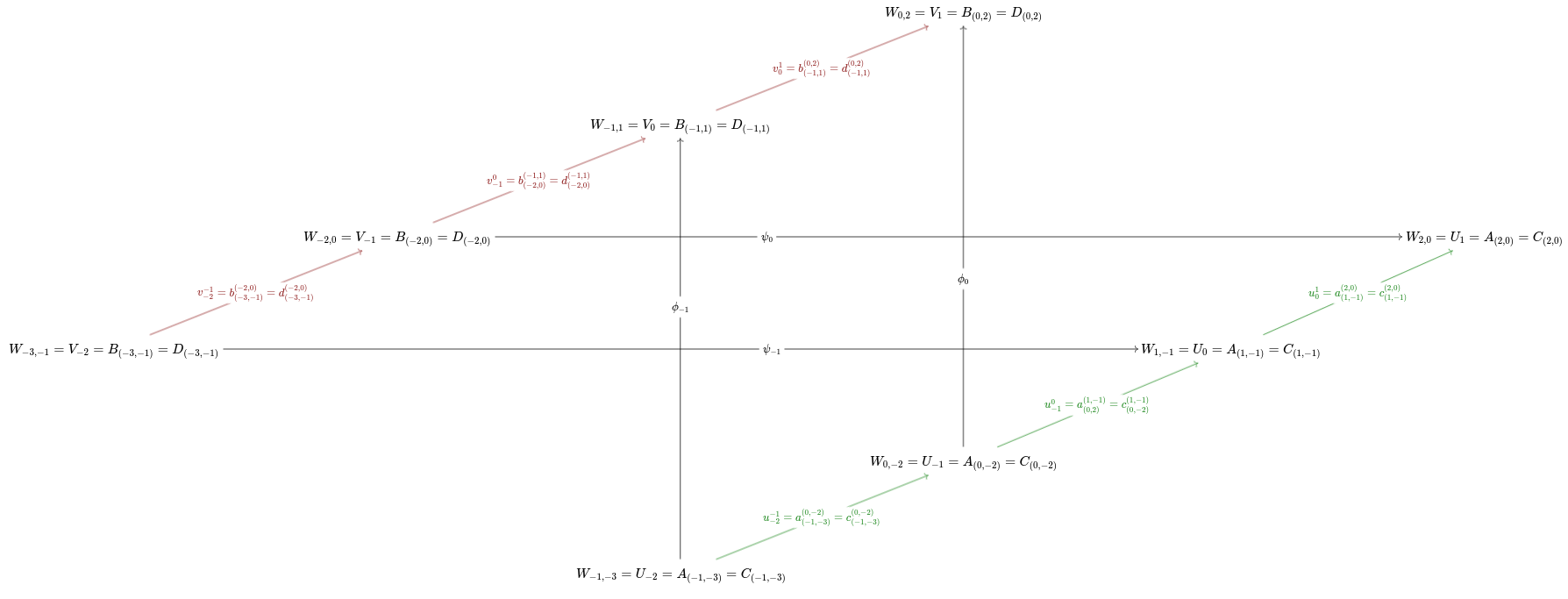
Define by the 2-by-2 matrix
of module maps. We claim is the desired extension.
- is isomorphic to .
- is isomorphic to .
- The cross maps of are precisely and .
The Interpolation Lemma (continued)
The Isometry Theorem
The main result is thaanks to Cohen-Steiner, Edelsbrunner and Harer in a 2007 paper.
The Interleaving Distance
Let and be -interleaved. Then for every , they are -interleaved by the maps
We want to make the interleaving parameter as small as possible. We may not be able to attain the actual minimum.
We say that and are -interleaved if they are -interleaved for all .
Example 4.1. Two persistence modules are isomorphic if and only if they are -interleaved.
Example 4.2. Let and be two non-isomorphic ephemeral modules ( for all ). Then are -interleaved but not 0-interleaved. Since and for all , it follows that the zero maps and are an -interleaving.
We define the interleaving distance between two persistence modules as
If there is no -interleaving, then we say .
Proposition 4.3
The interleaving distance satisfies the triangle inequality
Clearly, is symmetric; but it is not a metric. As we saw above in example 4.2, does not imply that . Instead, forms a pseudometric.
Proposition 4.5
Let be persistence modules. Then
The above proposition extends to a family of persistence modules:
The Bottleneck Distance
Recall that for a -tame persistence module every rectangle not touching the diagonal has finite -measure. this implies that
is a multiset in the extended open half-plane
We need to specify the distance between any pair of points in .
point-to-point: We use the -metric in ,
For points at infinity:
Proposition 4.6.
Let and be intervals and let and . Then
point-to-diagonal: We again use the metric:
half the distance from to the diagonal .
Proposition 4.7.
Let be an interval and . Then where 0 is the zero persistence module.
Proof: Let . The only -interleaving maps between and 0 must be zero maps, . It is -interleaving when . This is satisfied only when .
Q.E.D.
We can now define the bottleneck distance between two multisets in the extended half-plane. A partial matching between multisets and is a collection of pairs such that:
- for every there is at most one such that ;
- for every there is at most one such that . A partial matching is a -matching if
- if , then
- if is unmatched, then
- if is unmatched, then .
In other words, matched points are within of each other and any unmatched elements are within from the diagonal.
The bottleneck distance between two multisets in the extended half-plane is defined to be
If and are locally finite, we can replace the inf with a min.
Proposition 4.8
The bottleneck distance satisfies the triangle inequality.
Proof: Let be a -matching between and a -matching between . Let . Define
Notice that
- If , then
where is the point linking to .
- If is unmatched in , then either is unmatched in in which case
or but is unmatched in . But then
- If is unmatched in , then by a similar argument
Q.E.D.
Remark: Since are multisets, the composition operation between matchings is not uniquely defined. For example:

Theorem 4.9
Let be decomposable persistence modules. Then
The Bottleneck Distance (continued)
Locally finite multisets always have matchings.
Theorem 4.10
Let be locally finite multisets in the extended open half-plane . Suppose for every there exists an -matching between . Then there exists a -matching between .
Proof: For every , let be a -matching. Take a fixed enumeration of the countable set . Let be an indicator function of . Construct the descending sequence
where is defined recursively by taking the set
that has infinite cardinality as . We then construct another indicator function where is the value that is for all . We claim that is an indicator function for a -matching.
- For there is at most one such that .
- For with , there is at least one such that .
- For there is at most one such that .
- For with , there is at least one such that .
- If then .
Q.E.D.
The Isometry Theorem
For -tame modules, Theorem 4.9 becomes equality.
Theorem 4.11
Let be -tame persistence modules. Then
This theorem can be seen as the combination of two parts: the stability theorem
and the converse stability theorem
The Converse Stability Theorem
We already saw this result for decomposable modules in Theorem 4.9. We extend this to -tame modules.
Definition 4.12.
Let be a persistence module and . The -smoothing of is the persistence module defined to be the image of the following map:
i.e., is the image of the map .
We can factorize into a surjective and injective map by
where at any given index , the sequence is given by
These maps form an -interleaving.
Proposition 4.14
Let be a persistence module. Then .
Example 4.15: Let . Then
The -smoothing shrinks the interval module by on both ends.
Consider the -interval module which can be seen as the chain
Then for , the shift map gives use which can be seen as the chain
Proposition 4.16
The persistence diagram of is obtained from the persistence diagram of by applying the translation to the extended half-plane that lies above the line .
Corollary 4.17
Let be a -tame persistence module. Then .
Proof: Take the -matching
Q.E.D.
Smoothing -tame persistence modules can result in easier to work with modules.
Proposition 4.18
Let be a -tame persistence module over . Then is locally finite and decomposable into intervals.
With this we can finally prove the converse stability theorem:
Proof: Let be -tame persistence modules. Since are decomposable for any it follows that
Q.E.D.
Theorem 4.19
A persistence module is -tame if and only if it can be approximated, in the interleaving distance, by locally finite modules.
Question: Unclear what it means to be approximated by.
The Stability Theorem
We express the stability theorem inequality as a -matching.
Theorem 4.21
Let be -tame persistence modules that are -interleaved. Then there exists a -matching between the multisets .
(This result holds for -interleaved as well).
Let . The -thickening of is the rectangle
We also thicken a single point by taking the rectangle
of size -by- centered at .
Lemma 4.22 (Box lemma)
Let be a -interleaved pair of persistence modules. Let be a rectangle whose -thickening lies above the diagonal. Then and .
Proof: By the interleaving, the modules
and
can be viewed as the 8-term module
The rest follows from the restriction principle for quivers.
Q.E.D.
Proposition 4.23 shows that the box lemma holds for boxes at infinity.
The Measure Stability Theorem
Let be an open subset of . For , define the exit distance of to be
For the extended half-plane, we have that .
Let be multisets in . A -matching between is a partial matching such that
- if
- if is unmatched
- if is unmatched.
This is a generalization of -matchings in the half-plane which we get when .
Proposition 4.24
If are multisets in and there is a -matching between and a -matching between , then there is a -matching between and .
Theorem 4.25 (stability for finite measures)
Suppose is a 1-parameter family of finite -measures on an open set . Suppose for all the box inequality
holds for all rectangles whose -thickening belongs to . Then there exists a -matching between the undecorated diagrams and .
Examples
Partial Interleavings
Imagine comparing a filtered simplicial complex on an input point cloud to the sublevel set filtration of the density function it was sampled from. In the regions with low-density, samples may be too sparse to expect an interleaving. In such a case we may get a partial interleaving where the modules are interleaved only in high-density regions.
We say two persistence modules and are -interleaving up to time if there are maps and defined for all such that the diagrams below commute for all .

We still get a (albeit weaker) version of the stability theorem.
Theorem 5.1
Let and be two -tame persistence modules that are -interleaved up to time . Then, there is a partial matching with the following properties:
- Points in either diagram for which are not required to be matched.
- Points in either diagram for which are not required to be matched. All other points must be matched. Then
- If are matched, then the -coordinates of differ by at most .
- If are matched and one of lies below the line , then .
The proof constructs two new persistence modules called the truncations of to , where , that are defined with spaces
and maps
for all .
There are three steps to the proof:
- The decorated diagram of a persistence module determines the decorated diagram of its truncation by the following transformation:
that is, any points that are born and die before are unchanged, any points that are born before by die after are killed at time , and any points that are born after are ignored.
- If are -interleaved up to time , then are -interleaved.
- The stability theorem gives a -matching between and that may be lifted to a matching between and .
